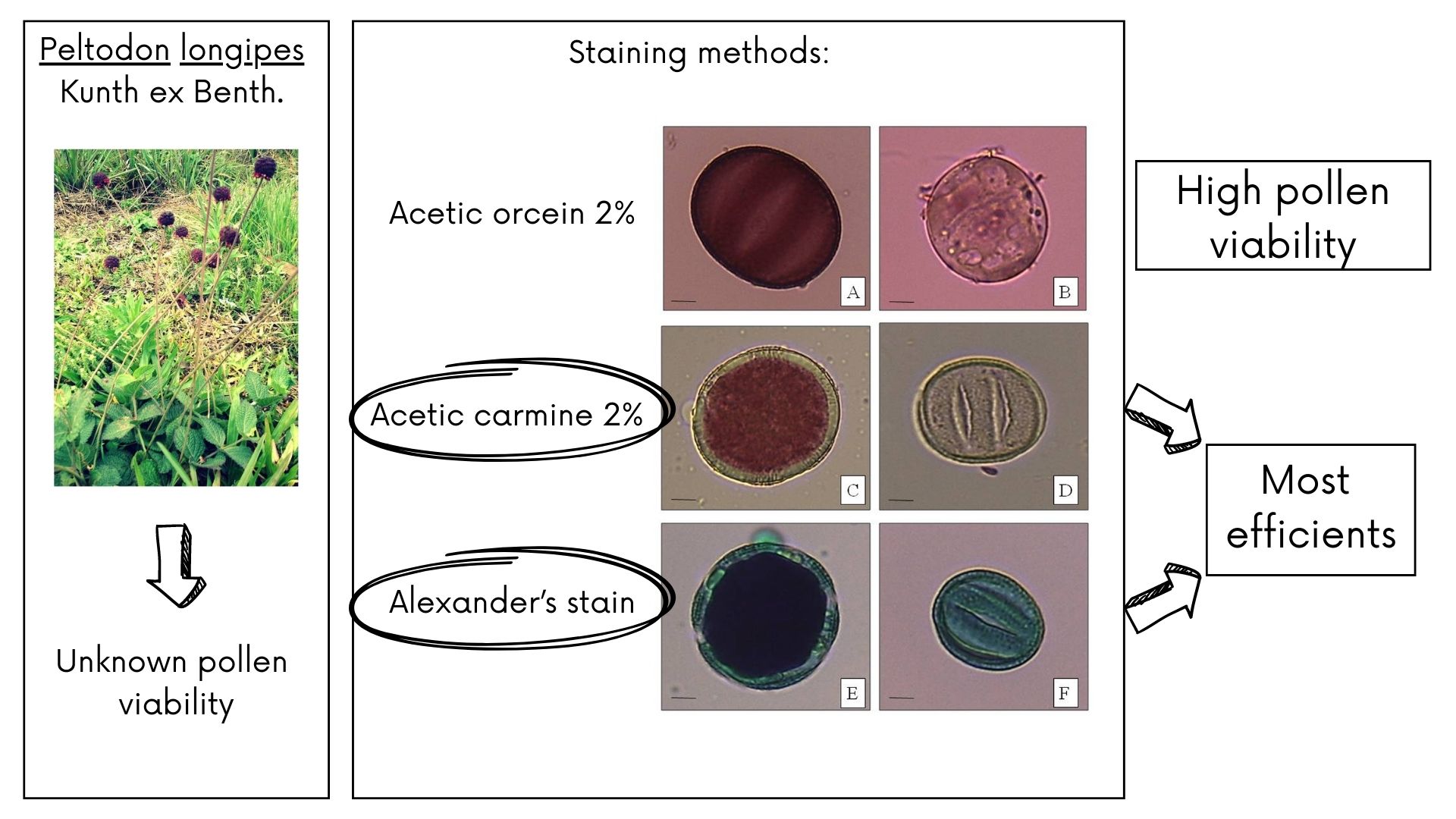Antiproliferative potential, antigenotoxic and phytochemical analysis of infusions of Baccharis dracunculifolia DC. on the cell cycle of Allium cepa L.
DOI:
https://doi.org/10.70151/nnhn4761Keywords:
Broom, Allium cepa test, Medicinal plantsAbstract
Baccharis dracunculifolia DC. is a medicinal specie populary know as broom, and has its use based on the preparation of infusions of the leaves to treat gastric desorders, physical fatigue, lack of apetite, fever diseases, and organic weakness. The study aimed to evaluate the potential antiproliferative, genotoxic and antigenotoxic of two populations of B. dracunculifolia on the Allium cepa L. test and perform the phytochemical analysis of the infusions of dry leaves. The botanical material consisted of leaves of two populations collected in Santa Maria and São Pedro do Sul, which were dried at room temperature. The experiment consisted of nine groups of four bulbs, each group corresponding to a treatment. The bulbs were rooted in water and then subjected to treatments for 24 hours. After this period, the roots of A. cepa were collected and fixed in Carnoy 3:1 for 24 hours and then stored refrigerated in 70% etanol until the preparation of the slides. The determination of phenolic compounds from aqueous extracts was performed by High Performance Liquid Chromatography (HPLC). The data obtained from the analisys of cell proliferation and genotoxicity have been submitted to the Chi-square test (p<0,05%). The results of the A. cepa test showed that aqueous extracts from B. dracunculifolia have antiproliferative and antigenotoxic potential. The cromatographic analysis indicated the presence of p-coumaric acid as major compound.
Downloads
References
Alaerts G, Matthijs N, Verbeke J, Heyden Y (2007) Chromatographic fingerprint development for herbal extracts: a screening and optimization methodology on monolithic columns. J Chromatogr A 1172(1): 1-8. http://doi.org/10.1016/j.chroma.2007.07.080.
Ayres M (2007) BioEstat 5.3: Aplicações estatísticas nas áreas das ciências biológicas e médicas. 5.ed. Belém: Sociedade Civil Mamirauá. 364p.
Cabrera GL, Rodriguez DMG (1999) Genotoxicity of soil from farmland irrigated with wastewater using three plant biossays. Mutat Res 426: 211-214. http://doi.org/10.1016/s0027-5107(99)00070-6.
Cruz LC, Ecker A, Dias RS, Seeger RL, Braga MM, Boligon AA, Martins IK, Costa-Silva DG, Barbosa NV, Cañedo AD, Posser T, Franco JL (2016) Brazilian pampa biome honey protects against mortality, locomotor deficits and oxidative stress induced by hypoxia/ reperfusion in adult Drosophila melanogaster. Neurochem Res 41: 116-129. http://doi.org/10.1007/s11064-015-1744-5
Dias M G, Canto-Dorow TS, Coelho APD, Tedesco SB (2014) Efeito genotóxico e antiproliferativo de Mikania cordifolia (L. F.) Willd. (Asteraceae) sobre o ciclo celular de Allium cepa L. Rev Bras Plantas Med 16(2): 202-208. https://doi.org/10.1590/S1516-05722014000200006.
Fachinetto JM, Tedesco SB (2009) Atividade antiproliferativa e mutagênica dos extratos aquosos de Baccharis trimera (Less.) A. P. de Candolle e Baccharis articulata (Lam.) Pers. (Asteraceae) sobre o sistema teste de Allium cepa. Rev Bras Plantas Med 11(4): 360-367. https://doi.org/10.1590/S1516-05722009000400002.
Fachinetto JM, Bagatini MD, Durigon J, Silva ACF, Tedesco SB (2007) Efeito anti-proliferativo das infusões de Achyrocline satureioides DC (Asteraceae) sobre o ciclo celular de Allium cepa. Rev Bras Farmacogn 17(1): 49-54. https://doi.org/10.1590/S0102-695X2007000100011.
Frescura VD (2014) Parâmetros fitoquímicos, genotóxicos e de crescimento de Alecrim (Rosmarinus officinalis L.) em diferentes salinidades e doses de nitrogênio. 111p. Tese (Doutorado – área de concentração Agronomia, Centro de Ciências Rurais, Universidade Federal de Santa Maria, Santa Maria, Brasil.
Frescura VD, Kuhn AW, Laughinghouse IV HD, Paranhos JT, Tedesco SB (2013) Post-treatment with plant extracts used in Brazilian folk medicine caused a partial reversal of the antiproliferative effect of glyphosate in the Allium cepa test. Biocell [online] 37(2): 23-28. https://doi.org/doi:10.32604/biocell.2013.37.023.
Frescura VD (2012) Avaliação do potencial antiproliferativo, genotóxico e antimutagênico das espécies Psychotria brachypoda (Müll. Arg.) Briton e Psychotria birotula Smith & Downs (Rubiaceae). 73 p. Dissertação (Mestrado – área de concentração Agrobiologia), Departamento de Biologia, Universidade Federal de Santa Maria, Santa Maria, Brasil.
Guerra M, Souza MJ (2002) Como observar cromossomos: um guia de técnicas em citogenética vegetal, animal e humana. Ribeirão Preto: FUNPEC, 131p.
Mori SA, Mattos Silva, LA, Lisboa G, Coradin L (1989) Manual de manejo do herbário fanerogâmico. Ilhéus: CEPLAC, 104 p.
Mors WB, Rizzini CT, Pereira, NA (2000) Medicinal plants of Brazil. Michigan: Reference Publications, 372p.
Nwanna EE, Oyeleye SI, Ogunsuyi OB, Oboh G, Boligon AA, Athayde ML (2016) In vitro neuroprotective properties of some commonly consumed green leafy vegetables in Southern Nigeria. NFS J 2:19-24. https://doi.org/10.1016/j.nfs.2015.12.002.
Pinheiro SMG (2016) Crescimento, composição fitoquímica e efeito genotóxico do óleo essencial em Alecrim (Rosmarinus officinalis L.) sob diferentes períodos de salinidade. 50 p. Dissertação (Mestrado – área de concentração Agronomia), Centro de Ciências Rurais, Universidade Federal de Santa Maria, Santa Maria, Brasil.
Rezende TP, Corrêa, JOA, Aarestrup BJV, Aarestrup FM, Sousa OV, Silva Filho AA (2014) Protective effects of Baccharis dracunculifolia leaves extract against carbon tetrachloride- and acetaminophen-induced hepatotoxicity in experimental animals. Molecules 19: 9257-9272. https://doi.org/10.3390/molecules19079257.
Souza Filho APS, Pereira AAG, Bayma JC (2005) Aleloquímico produzido pela gramínea forrageira Brachiaria humidicola. Planta Daninha 23(1): 25-32. https://doi.org/10.1590/S0100-83582005000100004.
Tedesco M (2015) Caracterização citogenética, compostos fenólicos e genotoxicidade de Sambucus australis Cham. & Schltdl. (Adoxaceae) 75 p. Dissertação (Mestrado – área de concentração Agrobiologia), Departamento de Biologia, Universidade Federal de Santa Maria, Santa Maria, Brasil.
Tedesco SB, Laughinghouse IV HD (2012) Bioindicador of Genotoxicity: The Allium cepa Test. In: Srivastava JK (Ed.). Environmental Contamination. Rijeka: InTech. 137–156. Disponível em: http://cdn.intechopen.com/pdfs-wm/29315.pdf.
Teixeira RO, Camparoto ML, Mantovani MS, Vicentini VEP (2003) Assessment of two medicinal plants, Psidium guajava L. and Achillea millefolium L. in in vitro assays. Genet Mol Biol 26,4:551-555. https://doi.org/10.1590/S1415-47572003000400021.
Vicentini, VEP, Camparoto ML, Teixeira RO, Mantovani, MS (2001) Averrhoa carambola L., Syzygium cumini (L.) Skeels and Cissus sicyoides L.: medicinal herbal tea effects on vegetal animals test systems. Acta Sci, 23(2): 593–598. https://doi.org/10.4025/actascibiolsci.v23i0.2716.

Downloads
Published
Issue
Section
License

This work is licensed under a Creative Commons Attribution-NonCommercial-NoDerivatives 4.0 International License.

